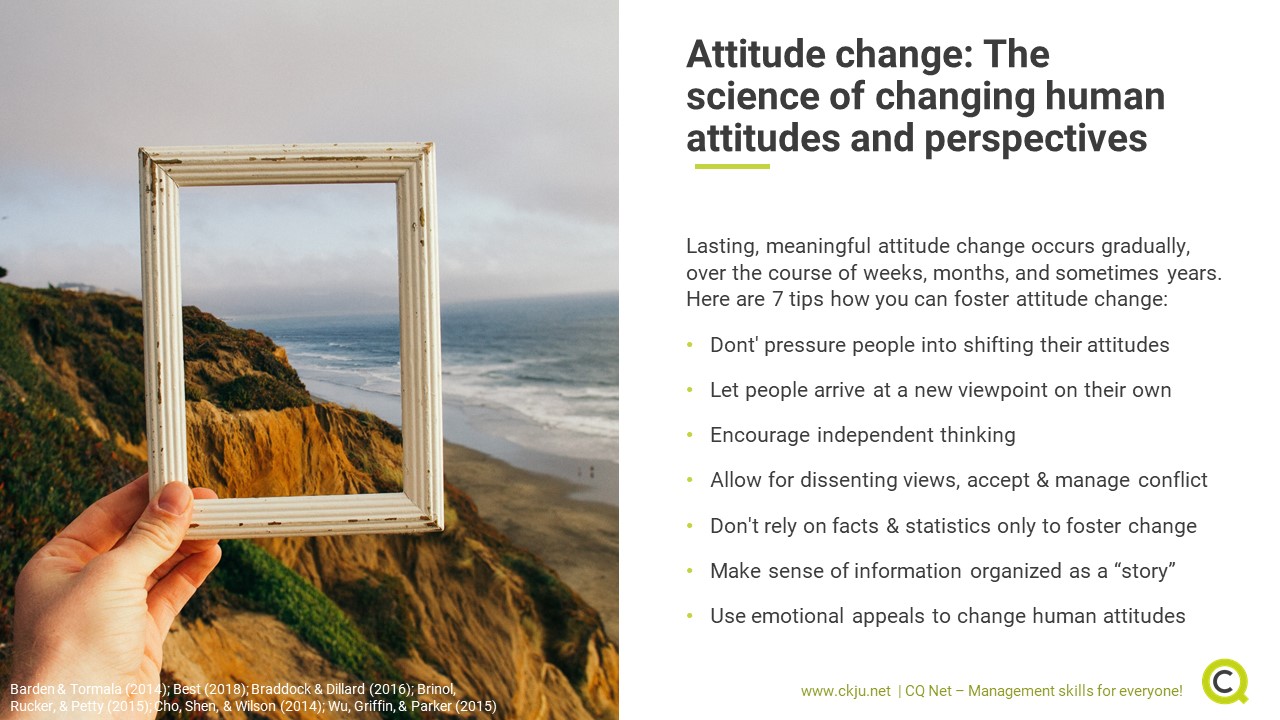- All Management Learning Resources
- Changing employee attitudes

Executive summary
As a professional, it is often your responsibility to inspire change and persuade people that a shift in outlook or process is needed. But given that changing a person’s attitude is extremely difficult, and that attempts at persuasion can backfire, how should you approach attitude change? Persuasion researchers have identified several methods of helping slowly shift employees’ views. Below are some of evidence-based tips for helping influence your employees’ attitudes and outlooks in a positive way.
Contents
- Executive summary
- Attitude change is difficult but part of any change management effort
- How to change attitudes? Attitute change occurs gradually
- Dont' pressure people into shifting their attitudes
- Let people arrive at a new viewpoint on their own
- Encourage independent thinking and give others agency
- Allow for dissenting views, accept and manage conflict in a constructive way
- Don't rely on facts and statistics only to foster attitude change
- Make sense of information organized as a “story” that progresses
- Use emotional appeals to change human attitudes
- Attitude change is one of a set of different change management levels
- Key take-aways
- References and further reading
Attitude change is difficult but part of any change management effort
Dynamic, vibrant organizations must be receptive to making big, necessary changes. Whether it’s undergoing a shift in goals to meet the changing nature of the economy, or altering work processes to boost productivity and other outcomes, change is essential, but difficult. Most people are reluctant to change their attitudes regarding what the best approach is, or to shift their outlook and reframe their goals (Vogel & Wanke, 2016); this is doubly true within organizations, where there is often an impetus to maintain “business as usual” (Reicher, Wanous, & Austin, 1997). Furthermore, attempts at persuasion often leave individuals more stubbornly entrenched in their pre-existing view (Banas & Richards, 2017).
How to change attitudes? Attitute change occurs gradually
As stated above, attitude change is difficult – most people are highly resistant to persuasion. This is especially true when a short-term attempt at changing a person’s view is made. Lasting, meaningful attitude change occurs gradually, over the course of weeks, months, and sometimes years (Brinol, Rucker, & Petty, 2015). It also tends to occur through meaningful, non-forceful discussions about competing viewpoints (LaCour & Green, 2014). The more an individual is allowed to slowly revise their views and arrive at a new outlook, the more effective an attempt at attitude change will typically be.
Dont' pressure people into shifting their attitudes
For you as a professional, the implications of this research are clear: do not try to pressure or cajole people into shifting their attitudes, outlooks and viewpoints. Even if you are seeking to energize, motivate, or encourage, direct attempts at changing how a person feels and thinks will be met with resistance. Instead, engage with your peers, team members or employees from a place of respect. Ask them to explain their viewpoints and feelings, and listen actively; when advocating for the view or process that you desire, speak from your own experience (Braddock & Dillard, 2016). While this process of positive influence may take a long time, and try your patience in some moments, it is far more likely to result in transformational outcomes (Yousef, 2017).
Let people arrive at a new viewpoint on their own
Research has shown consistently that when a person arrives at a new viewpoint on their own, their new attitude is more likely to be strong, impactful, and resistant to change (Barden & Tormala, 2014). Furthermore, the more deeply and carefully a person considers their beliefs and outlooks, the more likely they are to remain committed to those views, and the more likely it will be that this new outlook will influence behavior. People are generally more likely to seek out information on a topic, and reflect carefully upon it, and objectively about it, when they are able to choose to do so freely (Ranney & Clark, 2016).
Encourage independent thinking and give others agency
Rather than pushing a perspective or position on your employees, then, professionals should encourage independent thinking and give their peers, team members or employees agency. If you are seeking to implement a new process and want to convince employees that it is a desirable change, provide them with the same information that informed your decision. Let employees and team members see “behind the curtain” into your decision-making process, and grant them access to the research and logic that drives your managerial decisions.
Allow for dissenting views, accept and manage conflict in a constructive way
Allowing and encouraging your employees to reflect upon, and discuss, their views of the available information will leave them feeling empowered and valued, which will generally improve their work outcomes (Wu, Griffin, & Parker, 2015). In the short term, this may also result in vocal dissenting views, and hard conversations about whether your approach or outlook are the correct ones. However, as long as discussions remain civil and employees continue to do their work well, this increased autonomy and dissent will be beneficial. By trusting your employees to have agency and to form their own opinions, you are empowering them to engage in a meaningful, self-driven attitude shift (Vahasantanen, 2015).
Don't rely on facts and statistics only to foster attitude change
When making a persuasive case for your viewpoint, or trying to influence employees to take on a new outlook within an organization, be careful to not rely on dry facts or statistics. While crucial organizational decisions ought to be informed by empirical facts and scientific logic, most individuals are not persuaded by such information (Best, 2018). Facts and statistics are often uninteresting to people, and can be difficult to process into a coherent “big picture” idea of what is true or right. Most individuals are especially skeptical of the facts they are given when an attempt at persuasion is being made; people are acutely aware that figures and statistics can be altered, or cherry-picked, to make a convincing case (Hutchens et al, 2016).
Make sense of information organized as a “story” that progresses
Psychological research indicates that when seeking to influence employee attitudes, using captivating narratives and compelling emotions is beneficial. Most people think and process information in a “narrative” format; it is easier to make sense of information, or change within an organization, if it is organized as a “story” that progresses (Cho, Shen, & Wilson, 2014). When advocating for shifts in employee outlook, you can emphasize how the times have changed, and how the industry has evolved. You can also use your own personal narrative of attitude evolution to persuade employees – people are often positively influenced by learning about the shifting viewpoints and personal growth of others.
Use emotional appeals to change human attitudes
When attempting to influence employees’ attitudes or viewpoints, utilizing emotional appeals is also beneficial. An effective manager will not attempt to emotionally manipulate employees; rather, they will convey important points using genuine, personal feeling. When discussing a change in workplace processes, show authentic enthusiasm for the benefits it will bring. If attempting to convince a team to take on a new set of goals or a more long-term outlook, convey hopefulness and joy. An emotive, warm manager is more likely to be successful at transforming their employees’ attitudes in a positive way (Prochazka, Vaculik, & Smutny, 2015).
Attitude change is one of a set of different change management levels
Changing organizations is a complex process that requires you to consider management interventions on a variety of levels. Individuals and specifically individual attitudes is one of those levels we addressed in the CQ Dossier. Furthermore, you should also be aware of how to change employee habits and workflows. On an organizational level, it is change communication and future orientation that is crucial to manage change in an effective and efficient way.
Key take-aways
- Attitude change is gradual, and often requires multiple conversations with people of competing viewpoints.
- Attempts at directly persuading employees to take on a new outlook are likely to fail.
- To help employees shift in their outlooks, provide them with information, let them understand your logic, and give them autonomy to form their own views.
- Talking about your attitudes and views as a narrative “story” is more likely to be effective than conveying facts and figures.
- Positive, authentic emotions, such as hope and excitement, can help encourage shifts in employee viewpoints.
Management skills newsletter
Join our monthly newsletter to receive management tips, tricks and insights directly into your inbox!
References and further reading
Banas, J. A., & Richards, A. S. (2017). Apprehension or motivation to defend attitudes? Exploring the underlying threat mechanism in inoculation-induced resistance to persuasion. Communication Monographs, 84(2), 164-178.
Barden, J., & Tormala, Z. L. (2014). Elaboration and attitude strength: The new meta‐cognitive perspective. Social and Personality Psychology Compass, 8(1), 17-29.
Best, I. D. (2018). Translating the Information-to-Persuasion Ratio (Master's thesis).
Braddock, K., & Dillard, J. P. (2016). Meta-analytic evidence for the persuasive effect of narratives on beliefs, attitudes, intentions, and behaviors. Communication Monographs, 83(4), 446-467.
Briñol, P., Rucker, D. D., & Petty, R. E. (2015). Naïve theories about persuasion: Implications for information processing and consumer attitude change. International Journal of Advertising, 34(1), 85-106.
Cho, H., Shen, L., & Wilson, K. (2014). Perceived realism: Dimensions and roles in narrative persuasion. Communication Research, 41(6), 828-851.
Hutchens, M. J., Hmielowski, J. D., Pinkleton, B. E., & Beam, M. A. (2016). A spiral of skepticism? The relationship between citizens’ involvement with campaign information to their skepticism and political knowledge. Journalism & Mass Communication Quarterly, 93(4), 1073-1090.
LaCour, M. J., & Green, D. P. (2014). When contact changes minds: An experiment on transmission of support for gay equality. Science, 346(6215), 1366-1369.
Nabi, R. L. (2015). Emotional flow in persuasive health messages. Health Communication, 30(2), 114-124.
Prochazka, J., Vaculik, M., & Smutny, P. (2015). Leader’s Warmth, Transformational Leadership and Effectiveness. Journal of Advanced Management Science Vol, 3(2).
Ranney, M. A., & Clark, D. (2016). Climate change conceptual change: Scientific information can transform attitudes. Topics in Cognitive Science, 8(1), 49-75.
Reichers, A. E., Wanous, J. P., & Austin, J. T. (1997). Understanding and managing cynicism about organizational change. The Academy of Management Executive, 11(1), 48-59.
Vähäsantanen, K. (2015). Professional agency in the stream of change: Understanding educational change and teachers' professional identities. Teaching and Teacher Education, 47, 1-12.
Vogel, T., & Wanke, M. (2016). Attitudes and attitude change. Psychology Press.
Yousef, D. A. (2017). Organizational commitment, job satisfaction and attitudes toward organizational change: a study in the local government. International Journal of Public Administration, 40(1), 77-88.
About the Author







